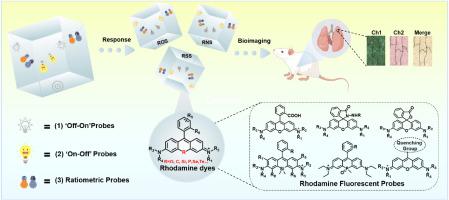Our official English website, www.x-mol.net, welcomes your feedback! (Note: you will need to create a separate account there.)
Recent progress and outlooks in rhodamine-based fluorescent probes for detection and imaging of reactive oxygen, nitrogen, and sulfur species
Talanta ( IF 6.1 ) Pub Date : 2024-04-01 , DOI: 10.1016/j.talanta.2024.126004 Ping Yang , A-Ling Tang , Shuai Tan , Guang-Ye Wang , Hou-Yun Huang , Wei Niu , Shi-Tao Liu , Mei-Hong Ge , Lin-Lin Yang , Feng Gao , Xiang Zhou , Li-Wei Liu , Song Yang
Talanta ( IF 6.1 ) Pub Date : 2024-04-01 , DOI: 10.1016/j.talanta.2024.126004 Ping Yang , A-Ling Tang , Shuai Tan , Guang-Ye Wang , Hou-Yun Huang , Wei Niu , Shi-Tao Liu , Mei-Hong Ge , Lin-Lin Yang , Feng Gao , Xiang Zhou , Li-Wei Liu , Song Yang

|
Reactive oxygen species (ROS), reactive nitrogen species (RNS), and reactive sulfur species (RSS) serve as vital mediators essential for preserving intracellular redox homeostasis within the human body, thereby possessing significant implications across physiological and pathological domains. Nevertheless, deviations from normal levels of ROS, RNS, and RSS disturb redox homeostasis, leading to detrimental consequences that compromise bodily integrity. This disruption is closely linked to the onset of various human diseases, thereby posing a substantial threat to human health and survival. Small-molecule fluorescent probes exhibit considerable potential as analytical instruments for the monitoring of ROS, RNS, and RSS due to their exceptional sensitivity and selectivity, operational simplicity, non-invasiveness, localization capabilities, and ability to facilitate optical signal generation for real-time dynamic analyte monitoring. Due to their distinctive transition from their spirocyclic form (non-fluorescent) to their ring-opened form (fluorescent), along with their exceptional light stability, broad wavelength range, high fluorescence quantum yield, and high extinction coefficient, rhodamine fluorophores have been extensively employed in the development of fluorescent probes. This review primarily concentrates on the investigation of fluorescent probes utilizing rhodamine dyes for ROS, RNS, and RSS detection from the perspective of different response groups since 2016. The scope of this review encompasses the design of probe structures, elucidation of response mechanisms, and exploration of biological applications.
中文翻译:

用于活性氧、氮和硫物质检测和成像的罗丹明基荧光探针的最新进展和展望
活性氧(ROS)、活性氮(RNS)和活性硫(RSS)是维持人体内细胞内氧化还原稳态所必需的重要介质,因此在生理和病理领域具有重要意义。然而,ROS、RNS 和 RSS 偏离正常水平会扰乱氧化还原稳态,导致损害身体完整性的有害后果。这种破坏与各种人类疾病的发生密切相关,从而对人类健康和生存构成重大威胁。小分子荧光探针由于其卓越的灵敏度和选择性、操作简单性、非侵入性、定位能力以及促进实时光学信号生成的能力,作为监测 ROS、RNS 和 RSS 的分析仪器展现出巨大的潜力动态分析物监测。由于其从螺环形式(非荧光)到开环形式(荧光)的独特转变,以及出色的光稳定性、宽波长范围、高荧光量子产率和高消光系数,罗丹明荧光团已被广泛应用。用于荧光探针的开发。本综述主要从2016年以来从不同反应群体的角度对利用罗丹明染料进行ROS、RNS和RSS检测的荧光探针进行研究。本综述的范围包括探针结构的设计、反应机制的阐明和探索的生物学应用。
更新日期:2024-04-01
中文翻译:

用于活性氧、氮和硫物质检测和成像的罗丹明基荧光探针的最新进展和展望
活性氧(ROS)、活性氮(RNS)和活性硫(RSS)是维持人体内细胞内氧化还原稳态所必需的重要介质,因此在生理和病理领域具有重要意义。然而,ROS、RNS 和 RSS 偏离正常水平会扰乱氧化还原稳态,导致损害身体完整性的有害后果。这种破坏与各种人类疾病的发生密切相关,从而对人类健康和生存构成重大威胁。小分子荧光探针由于其卓越的灵敏度和选择性、操作简单性、非侵入性、定位能力以及促进实时光学信号生成的能力,作为监测 ROS、RNS 和 RSS 的分析仪器展现出巨大的潜力动态分析物监测。由于其从螺环形式(非荧光)到开环形式(荧光)的独特转变,以及出色的光稳定性、宽波长范围、高荧光量子产率和高消光系数,罗丹明荧光团已被广泛应用。用于荧光探针的开发。本综述主要从2016年以来从不同反应群体的角度对利用罗丹明染料进行ROS、RNS和RSS检测的荧光探针进行研究。本综述的范围包括探针结构的设计、反应机制的阐明和探索的生物学应用。



























 京公网安备 11010802027423号
京公网安备 11010802027423号